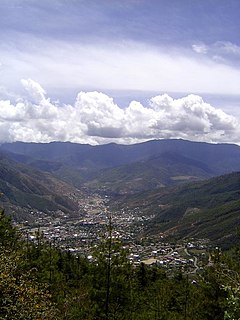
Chukha District is one of the 20 dzongkhag (districts) comprising Bhutan. The major town is Phuentsholing which is the gateway city along the sole road which connects India to western Bhutan. Chukha is the commercial and the financial capital of Bhutan. With Bhutan's oldest hydropower plant, Chukha hydel, and Tala Hydroelectricity Project, the country's largest power plant, Chukha is the dzongkhag which contributes the most to the GDP of the country. Also located in Chukha district are some of the country's oldest industrial companies like the Bhutan Carbide Chemical Limited (BCCL) and the Bhutan Boards Products Limited (BBPL).

Samtse District is one of the 20 dzongkhags (districts) comprising Bhutan. It comprises two subdistricts (dungkhags): Tashicholing and Dophuchen. They are further subdivided into 15 gewogs. The Samtse district covers a total area of 1304 sq km.
Articles related to Bhutan include:

Thimphu District is a dzongkhag (district) of Bhutan. Thimphu is also the capital of Bhutan and the largest city in the whole kingdom.
There are numerous ethnic groups in Bhutan, but the Ngalop people who speak the Dzongkha language constitute a majority of the Bhutanese population. The Bhutanese are of four main ethnic groups, which themselves are not necessarily exclusive: the politically and culturally dominant Ngalop of western and northern Bhutan; the Sharchop of eastern Bhutan; the Lhotshampa concentrated in southern Bhutan; and Bhutanese tribal and aboriginal peoples living in villages scattered throughout Bhutan.

The first Olympics that Bhutan participated in was the 1984 Los Angeles Olympics. For each Summer Olympic Games from then until 2008, Bhutan was only represented by archers. Archery is the national sport of Bhutan. The first non-archer to compete for Bhutan was Kunzang Choden in the 2012 Olympics. She competed in the women's 10m air-rifle event. The 2012 Bhutan team contained no men. Bhutan has never won an Olympic Medal. In spite of being very mountainous, it has never competed in the Winter Games.
Gudu is a Local Government Area in Sokoto State, Nigeria. Its headquarters are in the town of Balle.
Lhokpu, also Lhobikha or Taba-Damey-Bikha, is one of the autochthonous languages of Bhutan spoken by the Lhop people. It is spoken in southwestern Bhutan along the border of Samtse and Chukha Districts. Van Driem (2003) leaves it unclassified as a separate branch within the Sino-Tibetan language family.
Capital punishment in Bhutan was abolished on March 20, 2004 and is prohibited by the 2008 Constitution. The prohibition appears among a number of fundamental rights guaranteed by the Constitution; while some fundamental rights—such as voting, land ownership, and equal pay—extend only to Bhutanese citizens, the prohibition on capital punishment applies to all people within the kingdom.
Dorokha Gewog, now called Dophuchen Geog, is a gewog of Samtse District, Bhutan. Dorokha Gewog is part of Dorokha Dungkhag (sub-district), which comprise Dorokha and Denchukha Gewogs.
Tendu or Tendruk Gewog is a gewog of Samtse District, Bhutan. The Tendruk Gewog comprises part of Sipsu Dungkhag (sub-district), together with Bara, Biru, Lehereni, and Sipsu Gewogs.

Dechheling Gewog is a gewog of Pemagatshel District, Bhutan. Dechenling Gewog is part of Nganglam Dungkhag, along with Nganglam and Norbugang Gewogs.

Lauri Gewog is a gewog of Samdrup Jongkhar District, Bhutan. It was also part of Jomotsangkha Dungkhag (sub-district), together with Serthi Gewog.

Khaling Gewog is a gewog of Trashigang District, Bhutan. Khaling and Lumang Gewogs comprise Wamrong Dungkhag (sub-district).

Lumang Gewog is a gewog of Trashigang District, Bhutan. Lumang and Khaling Gewogs comprise Wamrong Dungkhag (sub-district).
Nganglam Gewog is a former gewog of Pemagatshel District, Bhutan. Nganglam Gewog is part of Nganglam Dungkhag, along with Dechenling and Norbugang Gewogs.
Lakha is a Southern Tibetic language spoken by about 8,000 people in Wangdue Phodrang and Trongsa Districts in central Bhutan. Lakha is spoken by descendants of pastoral yakherd communities.
The Chali language is an East Bodish language spoken by about 8,200 people in Wangmakhar, Gorsum and Tormazhong villages in Mongar District in eastern Bhutan, mainly around Chhali Gewog on east bank of Kuri Chhu River. Chalikha is related to Bumthangkha and Kurtöpkha.
The production of Bhutan wine is reported to have first been attempted in the 1990s, with the introduction of an experimental vineyard at Paro near Thimpu, the capital of Bhutan. Australian wine company, Taltarni, is believed to have provided technical help, but it is not known whether any wine was successfully produced.







